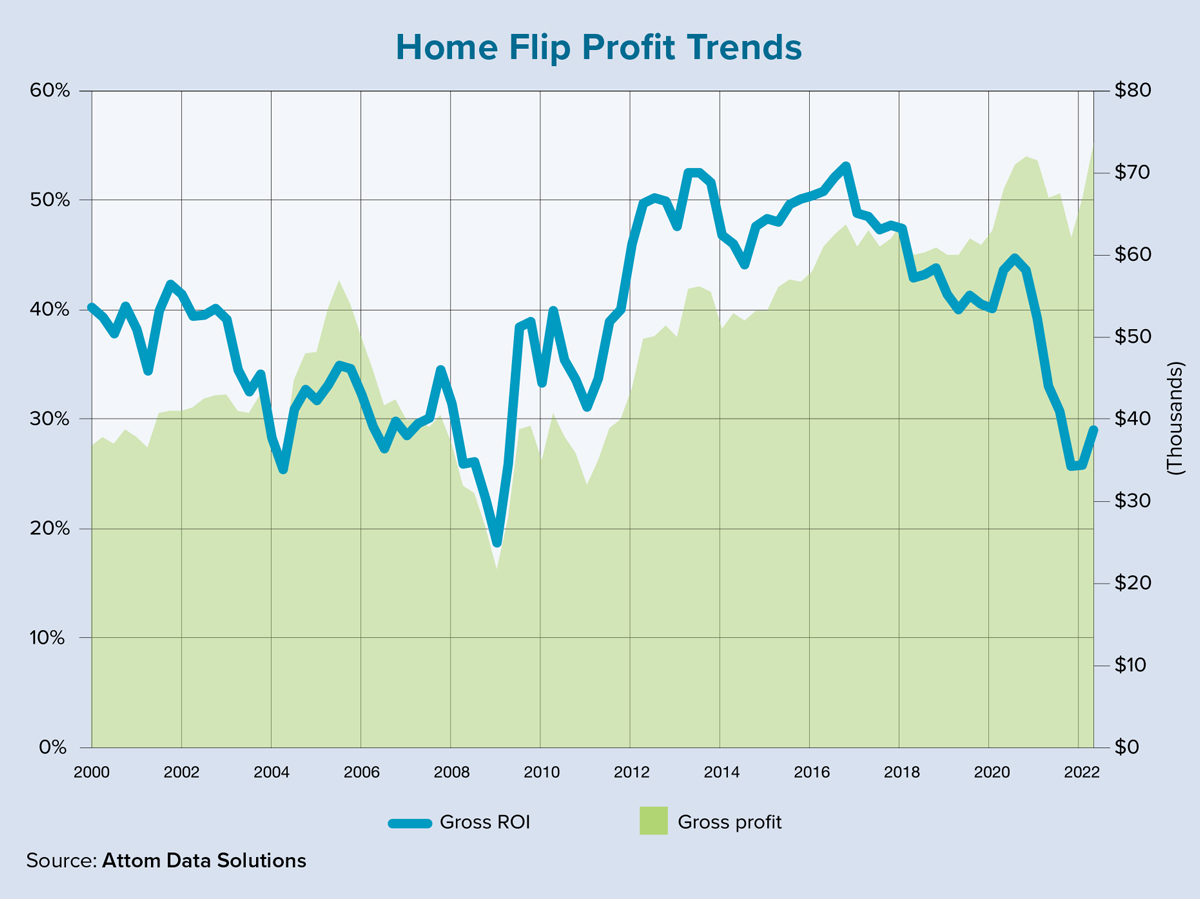Rising interest rates, high home prices and weakening demand have caused the fix-and-flip market to slow, but it still had a strong showing in second-quarter 2022, according to Attom Data Solutions’ U.S. Home Flipping Report.
From April through June, more than 115,000 single-family homes and condominiums were flipped, representing 8.2% of nationwide home sales. This was a decrease from the 9.7% share seen in Q1 2022, but it was still a significant year-over-year increase from the 5.3% share recorded in Q2 2021. It was the third-highest quarterly rate for U.S. home flips since 2000.
Along with the large number of fix-and-flip properties sold in second-quarter 2022, the median sales price for these homes ($328,000) was the highest ever recorded by Attom Data. This figure was only a slight increase from the median sales price of $327,000 in the prior quarter, but it was a 21.5% jump compared to the median price of $270,000 one year earlier.
Short-term investors have largely benefited from home prices that have been steadily increasing for years and are at historic peaks. In Q2 2022, the gross profit (the difference between the median purchase price paid by an investor and the median resale price) on the typical transaction was $73,700, a 10.1% annualized increase.
At the same time, typical gross profit margins reversed course and also were trending upward after six straight quarters of declines or stagnation. The gross profit of $73,700 translated into a 29% return on investment (ROI) compared to the original acquisition price. This ROI figure was up from 25.8% in first-quarter 2022, although it was down from 33% in Q2 2021 and significantly below the peak of 53.1% in 2016.
As with all things in real estate, second-quarter 2022 profits hinged heavily on location. The Northeast region saw some of the largest ROIs for flipped houses. Buffalo had the largest ROI at 133.2%, followed by Pittsburgh (127.3%); Lake Charles, Louisiana (125.5%); and the Pennsylvania cities of Scranton (109.9%) and Harrisburg (96%).
Among metro areas with at least 1 million residents, the largest ROIs were recorded in Philadelphia (82.1%), Detroit (77.8%) and Baltimore (73.5%). The smallest profit margins on the typical home flip occurred in areas with traditionally lower real estate prices. These cities include Tyler, Texas (1.4% return); Jackson, Mississippi (1.9%); Boise, Idaho (4.5%); Medford, Oregon (8.6%); and Lafayette, Louisiana (9.7%).
Overall rates of fix-and-flip activities also varied by location. Although home flips represented 8.2% of all sales nationally, areas in the West and Southeast regions saw significantly higher flip rates. The highest rate in Q2 2022 was posted by Tucson, Arizona, where flips made up 14.5% of all home sales. Tucson was followed by Phoenix (14.1%); Jacksonville (13.8%); Atlanta (13.6%); and Gainesville, Georgia (13.5%).
Large metro areas with a population of at least 1 million accounted for seven of the top 10 highest flip rates in Q2 2022. Charlotte, Tampa and San Antonio joined Tucson, Phoenix, Jacksonville and Atlanta in this group. Unsurprisingly, some of the lowest fix-and-flip rates occurred in areas with some of the highest home prices. These include Honolulu, where flips represented only 1.7% of all home sales, followed by Hilo, Hawaii (3.1%); Wichita, Kansas (3.5%); Bremerton, Washington (4%); and Seattle (4.3%).
Changing market conditions — including higher mortgage rates, weakening affordability and declining home sales — may have an impact on short-term real estate investment trends in the coming months. While there will still be opportunities for fix-and-flip investors, these trends bear watching as the market continues to play out. ●
-
Rick Sharga is the executive vice president of market intelligence at Attom Data Solutions. Sharga has more than 20 years of experience in the real estate and mortgage industries, having previously served in executive roles for RealtyTrac, Carrington Mortgage Holdings, TenX and Auction.com. He is one of the country’s most frequently quoted sources on real estate, mortgage and foreclosure trends. Sharga is a founding member of the Five Star Institute’s National Mortgage Servicing Association and is on the board of directors for the National Association of Default Professionals. Learn more about Attom Data Solutions at attomdata.com.
View all posts





